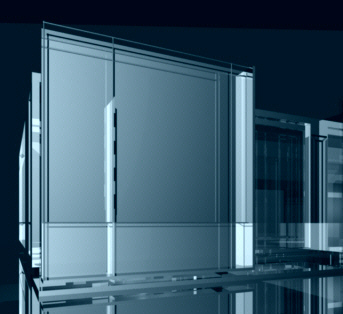|
Nonetheless there's a pragmatic interpretation of his detachment of façade from the program. According to
Rodríguez
Anza with time, changes in urban design, building use and remodeling demands of pre-standing structures, the schism he proposes between façade and building would allow for a high degree of adaptability. By 1998 he had focused completely on the development of formal codes to generate adaptable architectural bodies. These included the integration of structural and visual elements -a principle first applied in Mexican architecture in the late 50's, in a way that makes it hard to tell whether one is looking at a sculpture, a site installation, or an architectural rendition. The results of this particular mode were exhibited in Ex-Teresa, a center for alternative art, located in a XVII century church in downtown Mexico City.
The modules created for the Ex-Teresa show, entitled
Summons (1998), gave the impression of independent modules or formats which can be added on or interchanged to allow for an endless organic interplay of forms. The openings in the structures, and the transparency of glass, provided an elegant solution for protecting and highlighting previously built edifices and façades, creating the visual equivalent of a fusion between the grave, deep, sounds and slow rhythms of centuries old architecture and the bright, light and crisp melodies of Rodriguez Anza's lanthorn-like cases.
Summons defined and explored in depth the syntax of his proposal.
Multiplicity and adaptability marked the plan for Rodriguez Anza's architecture. If the pre-Hispanic temples had used the growing concept in their pyramids, by adding new layers of rock onto the existing structure, thus making a heavy structure grow in prominence and complexity, he would find the way to build on previously standing structures, but, and this is his personal approach, his proposal would be free standing, translucent, light weight, yet resistant and colorful in its own way. From here on two paradigms would emerge in his work: 1) to avoid masking the program of architecture by merely creating a decoration unrelated to the substance of the building, and 2), to regard the whole façade and structure as a replica of the social body, formed by different layers, stories, counterpoints, frames of mind, and purposes.

Isla Series (The
Nervion), 2000
These paradigms are brought into existence as both light and matter, each in its own right yet inseparable from the composition. A new visual vocabulary based on the proposed use of hi-tech materials, such as colored glass, wire tensors, and other super light weight materials of enormous resilience, underpin the digital drawings in the exhibition of a concentrated experience of light. Given that the opaque forms are minimized while the transparent are maximized, exactly the opposite of traditional architecture, these renditions make one appreciate the natural transition between inside-outside space, between the private and public realms. Nature and culture have found a way of coexisting without any barriers in between, perhaps the same dream that inspired Frank Lloyd Wright to create his utopian dwelling Fallingwater over a streambed.
While utopianism has inspired much of the 20th century architecture, Rodriguez Anza's architecture is taking the dream down into the urban and suburban environments of the present time. Transposing his modular concept into the urban landscape would reinforce the coherence between the city and the façade gridworks, softening the hard-edged, urban design with a growing environmentally sensitive architecture.
The "expandable building", as Rodriguez Anza has baptized his concept, offers several advantages for new developments. The first one being the independent evolution of its components, which grow longitudinally adapting the structure horizontally, thereby lessening the stress on the materials and the structure. In some cases the structure seems to hover just above the ground, harboring the expectation that it might inadvertently levitate. The chance for adapting to different programs allows for a constant integration into the existing space.
Rodriguez Anza's speculative renditions, both on paper and in models, arrive at a basic geometric module, a box made of cutting edge materials. His reductive esthetic, inspired in abstraction, is the starting point for his development of a way of understanding architecture as a two-sided problem. The rigid geometry of the linear module has become a self-imposed, like the pentagram, on which he can play infinite themes. While some of his predecessors heralded the age of revival of decoration, Rodriguez Anza uses the industrial products in a classical, orderly grid, all the while rejecting adornment and symbolism.
Art, architecture and design come together in these ideal works. And they do so by both adapting to vernacular buildings as facades or by proposing entirely new structures. His work is underpinned by a principle, that which states that the roof above man's head doesn't have to be encasing, but open to the environment, nature, space and, most importantly, time. A renewed vocabulary, full of color and transparencies, implies that architecture is as elastic as sculpture, painting and music; architecture integrates all these into one.
|
|
